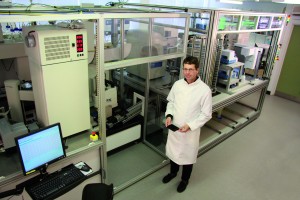THURSDAY, 1 OCTOBER 2009
Meet Adam, the first of a new generation of electronic scientists. Adam lacks your dexterity, creativity and fleshy looks, but this robot is the first to demonstrate the abilities many rely on to conduct their research. Created by researchers from Cambridge and Aberystwyth, Adam has the ability to conduct experiments, analyse results and develop hypotheses. You might say that any researcher could complete these activities. However, can any researcher work non-stop, devoting all their attention to the research? Adam can work continuously and progress automatically through every step of the scientific process.Adam is not the first robot to assist with scientific research. Robots with a range of functions are already used in a variety of disciplines, each designed to make scientists’ research faster, easier and more cost-effective. The basic functions of these robots include automated pipetting, sampling and measurement; repetitive activities that prove tedious for humans. For instance, the introduction of automated chromatography has improved the speed of compound purification: accelerating chemical synthesis and pharmaceutical drug development. Using robots allows scientists to run multiple experiments at once, maximising output and advancing the pace of research.
Robots with more advanced functions are used where conditions prevent investigation by human scientists. Robots are currently conducting research in a number of extreme environments, including the surface of spaceships, the inside of volcanoes and the bottom of oceans. Examples include Dante I and II for exploring volcanoes in Alaska, the Mars Lander and Sentry for deep-sea investigations.
All previous robots – from the very basic automated pipetter to the advanced Mars Rover – have two main limitations: they cannot interpret the significance of their results or plan new experiments. At most, these robotic assistants collect data for humans to analyse. This has led to a bottleneck, particularly in the biological sciences, where robots are generating new data faster than human scientists can retrieve and analyse it. Enter Adam and his kin.
With the ability to both conduct experiments and to draw conclusions from the results, Adam is a significant technological breakthrough. Previously separate functions of robots and humans can now smoothly proceed in one continuous process, sidestepping the human bottleneck. This revolution in automation is made possible by a process termed ‘active learning’. Active learning involves a cycle of experimentation and analysis, where each successive experiment is derived from the previous results. With each new set of data, the robot scientist is able to generate new hypotheses to explain the experimental results. Subsequently, the robot scientist uses the same logical programming to determine which experiments have the highest chance of falsifying the greatest number of potential hypotheses.
In the case of Adam, this iterative logic process was applied to the field of genetics. Adam investigates the effects of different growth conditions on the proliferation of selected yeast strains. This data is then used to match genes from the yeast Saccharomyces cerevisiae with the enzymes that they encode. During experimentation, Adam performs five basic operations, from the retrieval of selected yeast strains and frozen storage to measurement of growth using an automated plate reader. Similar to a student gaining background knowledge on their research, Adam required the input of background information on various topics, including knowledgeof S. cerevisiae metabolism, before he tackled the problem of yeast genetics. With this background knowledge and advanced software for hypothesis creation and experiment design, Adam was able to hypothesise that one enzyme was encoded by three distinct genes: a conclusion, subsequently verified by results obtained manually by human colleagues.
The result of Adam’s experimentation was understandably a modest discovery, yet it hints at a future where humans and robots work as a team to investigate some of the most time consuming challenges in science.
Rose Spear is a PhD student in the Department of Materials Science and Metallurgy

